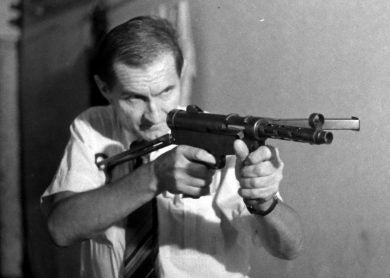Looks like it’s becoming a series here in TFB to show some South American countries’ earliest and generally unknown submachine gun designs. This time it’s from Argentina, where a designer called Juan Lehnar produced the single prototype of a particularly well-finished 9x19mm selective fire gun in the early 1930s.
Of pretty conventional blowback, open-bolt operation, it featured a cylindrical receiver to house the similar-shaped bolt and return spring. The barrel (length unknown) was involved by a metal sleeve with 12 longitudinal perforations to aid in the heat-dissipation/cooling process, in addition to having most of its length machined in radial fins (remember the M1928A1 Thompson?). The lower receiver housed the firing mechanism, with the fire selector on the left side above the pistol grip with the markings “TIRO” (semi-auto), top; “AUTO” (full-auto), center; and “SEG” (safe), down. Cyclic rate of fire was reported to be in the region of 550 rounds per minute.

Right-side view of the Lehnar SMG in the firing configuration, magazine on the left side, stock extended, forward grip down.

The prototype with the forward grip folded back, stock partially folded down, curved magazine removed. The barrel’s machined cooling fins are discernible through the openings in the external jacket.
There was a wooden forward grip that could be folded rearward, and the skeleton buttstock could be swung forward, thus reducing the gun’s overall length from 700 to 410mm. The 32-round, curved magazine (staggered-column, single position feed) was inserted into the left side, while its housing could be rotated upwards to make the SMG somewhat more compact for transport, at the same time closing the ejection port. The sights (hood-protected front post and 100-200m side-protected notch rear sight) had a radius of 320mm. No weight figures are available.

The gun in the, eh, ‘travelling’ mode. Note that the housing for the curved magazine is rotated upwards, at the same time closing the ejection window.

This closer view shows the magazine housing in the normal position on the left side of gun, while the fire selector markings are perceptible. The pistol grip side panels were made of wood.
This rare prototype was shown to me in Buenos Aires in February 1990 by Pantaleon Kotelchuck, a local gun wizard who worked for the Federal Police at the time and who was also a leading technical advisor to Argentina’s RENAR (Registro Nacional de Armas, National Firearms Register). He passed away in 1993 at the early age of 54.

Argentine gun wizard Pantaleon Kotelchuck posing with the Lehnar subgun for the author in Buenos Aires, February 1990. Note that the weapon is uncocked (bolt forward). Well, just posing…

“Panta” and the Lehnar… ready for business!
Gracias, amigo “Panta”! R.I.P.
 Your Privacy Choices
Your Privacy Choices
